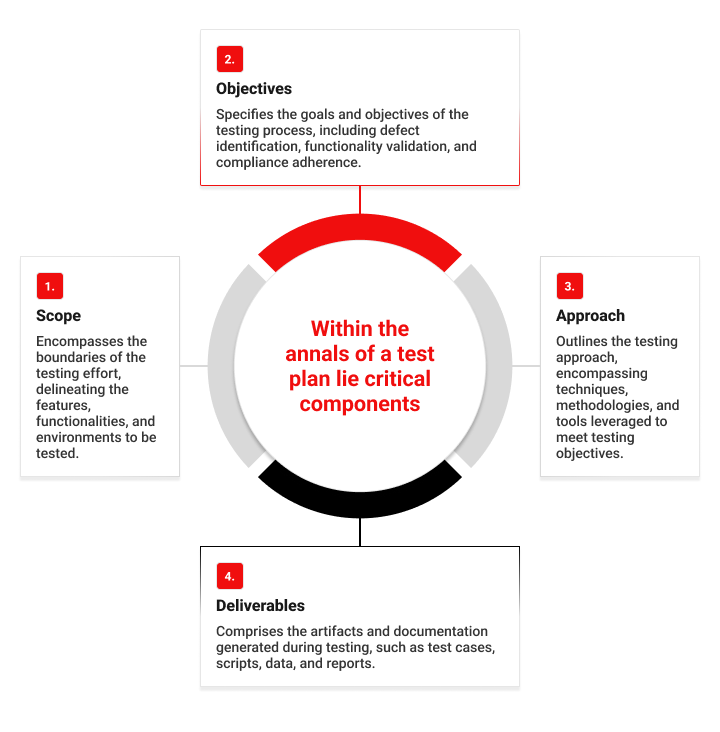Under software testing, a test plan acts as a blueprint, delineating the scope, objectives, approach, resources, and schedule for testing activities. On the other hand, a robust test automation strategy offers a high-level plan that outlines the overall approach to testing. It encompasses the selection of testing techniques, tools, and methodologies, providing a roadmap for organizing, executing, and managing testing efforts throughout the software development lifecycle.
However, for successful software testing, clarity in test planning and strategy is paramount. Test automation strategy seeks to streamline testing processes, bolster efficiency, and hasten testing cycles by automating repetitive tasks. However, without well-defined test plans and strategies, automation efforts may veer off course, leading to inefficiencies, delays, and suboptimal outcomes. Clear test plans and strategies ensure that automation endeavors align with business goals, testing requirements, and project constraints.
Test Plan: Key Components and Objectives
At its core, the test plan serves as a comprehensive document, articulating the scope, objectives, approach, and deliverables of the testing process. It offers stakeholders a panoramic view of the testing activities to be undertaken, along with the requisite resources and timeline.

Clarity in test objectives and success criteria is paramount to ensuring that testing activities align with business and project requisites. These delineations offer stakeholders a lucid understanding of the testing purpose and expected outcomes, providing measurable yardsticks of testing efficacy and comprehensiveness.
Test Automation Strategy: Framework and Approach
Test automation strategy encapsulates the selection of testing techniques, methodologies, and tools, offering a blueprint for organizing, executing, and managing testing activities across the software development lifecycle.
Diverse test strategies, such as risk-based, exploratory, and regression testing, furnish distinct approaches to addressing testing challenges and achieving objectives. Risk-based testing prioritizes testing based on risk levels, while exploratory testing explores software behavior intuitively, relying on tester experience. Regression testing safeguards against new defects, ensuring the stability of existing functionality. Opting for the right strategy hinges on project requisites and constraints, ensuring optimal testing outcomes.
Selecting a robust test automation strategy hinges on project exigencies and constraints. Each strategy proffers unique benefits and trade-offs, necessitating a judicious evaluation of testing needs, project goals, and resource constraints. Through meticulous strategy selection, organizations can optimize testing endeavors and fulfill desired outcomes within temporal, budgetary, and resource confines.
Test Planning Activities
- Identification of Testing Scope, Including Features, Functionalities, and Environments: Mapping the testing scope entails delineating features, functionalities, and environments earmarked for testing. This ensures focus and purpose in testing activities, aligning them with project imperatives.
- Defining Test Objectives, Test Scenarios, and Test Cases: Defining test objectives, scenarios, and cases involves setting goals, conditions, and validation parameters for testing. This fosters alignment with business requirements and user expectations.
- Estimating Testing Effort and Resources Required: Estimating testing effort and resources involves gauging temporal, human, and infrastructural requisites for testing activities. This aids in efficient resource allocation and adherence to project timelines and budgets.
- Planning for Test Data and Environment Setup: Mapping test data and environment requisites ensures appropriate setup for testing activities. This guarantees testing environments are duly configured, and requisite data is available for comprehensive test execution.
Defining Test Execution and Reporting Processes
- Planning for Test Execution, Including Scheduling, Prioritization, and Environment Setup: Planning test execution encompasses scheduling, prioritizing, and environment setup, ensuring methodical and efficient test execution aligned with project timelines and priorities.
- Establishing Criteria for Test Execution, Including Entry and Exit Criteria: Setting criteria for test execution, encompassing entry and exit conditions, ensures consistent and well-defined testing processes, fostering transparency and accountability.
- Defining Metrics and KPIs for Measuring Test Effectiveness and Progress: Defining metrics and KPIs facilitates monitoring of test effectiveness and progress, enabling informed decision-making and continuous improvement initiatives.
- Establishing Processes for Defect Tracking and Reporting: Establishing defect tracking and reporting processes ensures effective management of defects throughout the testing lifecycle, fostering transparency and facilitating timely resolution.
Continuous Improvement and Adaptation
- Importance of Continuous Improvement in Test Planning and Strategy: Continuous improvement fosters refinement and enhancement of testing processes, ensuring alignment with evolving project requisites and industry best practices.
- Strategies for Gathering Feedback and Lessons Learned from Test Execution: Gathering feedback and lessons learned from testing activities enables the identification of best practices, challenges, and opportunities for improvement, fostering iterative refinement of testing processes.
- Iterative Refinement of Test Plans and Strategies Based on Feedback and Changing Project Requirements: Iterative refinement of test plans and strategies based on feedback and changing requirements ensures ongoing alignment with project goals, driving continual improvement and optimization of testing endeavors.
Rundown!
Clear test planning and test automation strategy are indispensable pillars for successful test automation. They provide direction and structure, ensuring alignment with business objectives, testing requirements, and project constraints, thereby optimizing testing outcomes.
As organizations embrace Agile, DevOps, and continuous testing methodologies, the role of test planning and strategy evolves, necessitating organizations to remain agile, proactive, and responsive to evolving project dynamics and industry trends. By embracing change and embodying the principles of the Test Automation Strategy, organizations can navigate the ever-evolving landscape of software testing and drive innovation, quality, and success in their testing endeavors.



